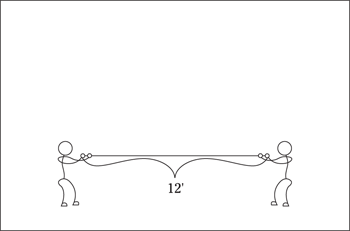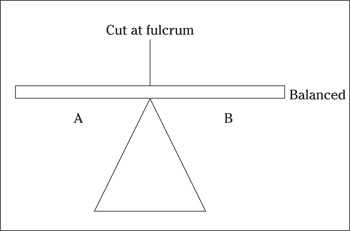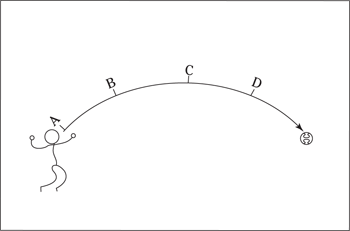Chapter 18
Army Selection Instrument for Flight Training (SIFT) Practice Test
The Army Selection Instrument for Flight Training (SIFT) test replaced the Alternate Flight Aptitude Selection Test (AFAST) effective January 2013. The SIFT is made up of seven subtests totaling a minimum of 235 questions, and it takes between two and three hours to complete. (Note: The practice test in this chapter is a shortened version of a SIFT test. In the affected subtests, we note the time allotted and number of questions for both the full test and for this shorter test.)
The SIFT assesses your mathematical skills and aptitude, ability to extract meaning from written passages, familiarity with mechanical concepts and simple machines, ability to mentally determine an aircraft’s orientation in three-dimensional space, and ability to quickly recognize patterns within objects and groups of images. The SIFT also measures your knowledge of aviation terminology, familiarity with aircraft (fixed- and rotary-wing) components and function, and grasp and knowledge of basic flight fundamentals and aerodynamic principles.
You can’t use a calculator on the SIFT; the math problems on the exam are designed to be completed without one. You do get a few formulas and scrap paper to help with your calculations. Keep in mind that some of the questions in this practice test are designed to explain a concept and may be difficult to solve. If you can’t do the problem without a calculator, go ahead and do it with a calculator but then immediately do the calculation again by hand. This strategy will better prepare you for the actual test.
The SIFT is available only in a computer-based format. The system determines whether you pass or fail immediately, and you receive your score upon completion of the test. Possible scores range from 20 to 80, with an average of 50. The current minimum qualifying score to apply for the Army’s aviation program is 40. Because the SIFT is a new test and is still being validated as of this writing, the minimum score needed to pass, as well as certain subtests, may change to correspond with the Army’s aviation accessions requirements.
If you pass, you’re no longer authorized to retake the SIFT, so if you barely pass and want to try again to beef up your score, you’re out of luck. If you fail to attain a minimum qualifying score on your first attempt, you may retake the SIFT once, no earlier than the 181st day following the previous attempt. (So if you fail your first attempt on January 1, the earliest you can retake the test is July 1.) If you fail on your second attempt, you can’t take the SIFT again.
SIFT Test Structure
The SIFT is designed to predict success in aviation training. The test comprises seven subtests and takes between two and three hours (including administrative time and an optional exam break) to complete. Here’s how the subtests of the SIFT break down:
|
Subtest |
# of items |
Time |
|
1. Simple Drawings (SD) |
100 |
2 minutes |
|
2. Hidden Figures (HF) |
50 |
5 minutes |
|
3. Army Aviation Information Test (AAIT) |
40 |
30 minutes |
|
4. Spatial Apperception Test (SAT) |
25 |
10 minutes |
|
5. Reading Comprehension Test (RCT) |
20 |
30 minutes |
|
6. Math Skills Test (MST) |
Varies |
40 minutes |
|
7. Mechanical Comprehension Test (MCT) |
Varies |
15 minutes |
Subtest 1
Simple Drawings
This subtest tests your ability to recognize which simple figure within a group of five simple figures does not belong with the others. This type of question is pretty easy, but most test-takers have a hard time completing all the questions in this subtest. Individual question completion speed is critical to your success on this subtest.
Time: 2 minutes for 100 questions. In this practice test, we give you 30 seconds for 25 questions.
Directions: With each question, you see five figures, lettered A, B, C, D, and E. Identify which simple figure does not belong with the others.
1.

2.

3.

4.

5.

6.

7.

8.

9.

10.

11.

12.

13.

14.

15.

16.

17.

18.

19.

20.

21.

22.

23.

24.

25.


Subtest 2
Hidden Figures
This subtest tests your ability to recognize a simple figure in a complex drawing.
Time: 5 minutes for 50 questions. In this practice test, we give you 1 minute 30 seconds for 15 questions.
Directions: Before each question, you see five figures, lettered A, B, C, D, and E. Below the figures are numbered drawings; for each drawing, identify which simple figure is in the complex drawing.
26.–30.

26.

27.

28.

29.

30.

31.–35.

31.

32.

33.

34.

35.

36.–40.

36.

37.

38.

39.

40.


Subtest 3
Army Aviation Information Test
This subtest deals with your general understanding of the principles of helicopter flight.
Time: 30 minutes for 40 questions. In this practice test, we give you 15 minutes for 20 questions.
Directions: Each question contains an incomplete statement followed by five choices. Select the choice that best completes the statement.
41. During a hover, a helicopter tends to drift to the right. To compensate for this effect, some helicopters
(A) Have the tail rotor tilted to the left
(B) Have the tail rotor tilted to the right
(C) Have the rotor mast rigged to the left side
(D) Are typically loaded with an aft CG
(E) Both Choice (A) and Choice (C)
42. The four forces that act on an aircraft in flight are
(A) Lift, weight, thrust, and drag
(B) Lift, mass, propulsion, and resistance
(C) Aerodynamics, mass, propulsion, and drag
(D) Lift magnitude, mass, thrust, and drag
(E) Roll, pitch, yaw, and magnitude
43. A helicopter’s cyclic control is a mechanical linkage used to change the pitch of the main rotor blades
(A) All at the same time
(B) At a selected point in its circular pathway
(C) Proportionally to the engine’s rpm
(D) In conjunction with the desired speed
(E) For vertical flight only
44. The lift differential that exists between the advancing main rotor blade and the retreating main rotor blade is known as
(A) Coriolis effect
(B) Dissymmetry of lift
(C) Translating tendency
(D) Translational lift
(E) Lift vector
45. The primary purpose of the tail rotor system is to
(A) Assist in making coordinated turns
(B) Maintain heading during forward flight
(C) Deflect adverse yaw
(D) Counteract the torque effect of the main rotor
(E) Allow coordinated flight
46. The upward bending of the rotor blades resulting from the combination of lift and centrifugal forces is known as
(A) Translational lift
(B) Coning
(C) Blade flapping
(D) Inertia
(E) Translating tendency
47. During a hover, the helicopter tends to drift in the direction of tail rotor thrust. This movement is called
(A) Flapping
(B) Coriolis force
(C) Transverse flow effect
(D) Translating tendency
(E) Gyroscopic precession
48. Which of the following does not affect density altitude?
(A) Temperature
(B) Altitude
(C) Atmospheric pressure
(D) Wind velocity
(E) Humidity
49. What action should a helicopter pilot take if engine failure occurs at altitude?
(A) Raise the collective pitch.
(B) Aft cyclic and increase collective pitch.
(C) Increase the throttle.
(D) Lower the collective pitch control to maintain rotor rpm.
(E) Reduce cyclic back pressure.
50. A helicopter center of gravity is usually located
(A) Directly below the main fuel tank
(B) In front of the main rotor mast
(C) Directly above the main fuel tank
(D) In the rear of the main rotor mast
(E) A short distance fore and aft of the main rotor mast
51. Foot pedals in the helicopter crew member station enable the pilot to
(A) Control torque effect
(B) Regulate flight speed
(C) Regulate rate of decent
(D) Regulate rate of climb
(E) Stabilize rotor rpm
52. Gyroscopic precision happens when
(A) A force applied to a spinning disc has its effect 90 degrees later in the opposite direction and plane of rotation
(B) A force applied to a spinning disc has its effect 180 degrees later in the direction and plane of rotation
(C) A force applied to a spinning disc has its effect 90 degrees later in the direction and plane of rotation
(D) A force applied to a spinning disc has its effect 180 degrees later in the opposite direction and plane of rotation
(E) None of the above
53. Translational lift is
(A) The lift needed to initially leave the ground
(B) The cushioning effect encountered in a low hover
(C) Lift developed from forward airspeed
(D) The additional lift gained when the helicopter leaves the disturbed air from its rotor downwash
(E) The decreased lift suffered when the helicopter leaves its downwash
54. Ground effect is most likely to result in which problem?
(A) Inability to get airborne on a smooth surface
(B) Settling to the surface abruptly during landing
(C) Becoming airborne before reaching appropriate takeoff speed
(D) The creation of wake turbulence
(E) An increased amount of drag
55. Lift differential (the result of one rotor losing lift because of an advancing aircraft’s forward airspeed) that exists between the advancing main rotor and the retreating rotor blade is known as
(A) Translating tendency
(B) Transverse flow effect
(C) Unequal lift effect
(D) Retreating blade stall
(E) Coriolis effect
56. The combination of factors that reduces helicopter performance the most is
(A) High density altitude, heavy gross weight, and calm or no wind
(B) Low density altitude, light gross weight, and moderate-to-strong wind
(C) Low density altitude, light gross weight, and calm or no wind
(D) Low density altitude, heavy gross weight, and moderate-to-strong wind
(E) High density altitude, light gross weight, and moderate-to-strong wind
57. The cyclic controls the
(A) Gyroscopic precession of the rotor blade
(B) Torque effect
(C) Engine rpm
(D) Direction of the tilt of the main rotor
(E) Pitch of the helicopter
58. The degree of movement of an aircraft around its lateral axis is known as
(A) Yaw
(B) Roll
(C) Bank
(D) Pitch
(E) Sideslip
59. The method of control by which the pitch of all main rotor blades is varied equally and simultaneously is the
(A) Torsion control
(B) Collective control
(C) Cyclic control
(D) Tail rotor control
(E) Throttle control
60. Lift is the upward force created by
(A) Airflow as it passes around an airfoil
(B) Blade flapping
(C) Torque
(D) Thrust
(E) Airspeed

Subtest 4
Spatial Apperception Test
This subtest checks your ability to match external and internal views of an aircraft when you’re given visual information about the aircraft’s direction and orientation relative to the ground. Each question provides a view from inside the cockpit; you then have to match that diagram to one of five external views. It is assumed that when you look at the exterior view, your position is south of the aircraft looking north.
Time: 10 minutes for 25 questions
Directions: In each question, you see a pilot’s view from the crew member station. Next, you see a series of five exterior, three-dimensional viewpoints of various aircraft, and you must select which aircraft best represents what’s shown in the first picture.
61.

Illustration by Wiley, Composition Services Graphics
62.

Illustration by Wiley, Composition Services Graphics
63.

Illustration by Wiley, Composition Services Graphics
64.

Illustration by Wiley, Composition Services Graphics
65.

Illustration by Wiley, Composition Services Graphics
66.

Illustration by Wiley, Composition Services Graphics
67.

Illustration by Wiley, Composition Services Graphics
68.

Illustration by Wiley, Composition Services Graphics
69.

Illustration by Wiley, Composition Services Graphics
70.

Illustration by Wiley, Composition Services Graphics
71.

Illustration by Wiley, Composition Services Graphics
72.

Illustration by Wiley, Composition Services Graphics
73.

Illustration by Wiley, Composition Services Graphics
74.

Illustration by Wiley, Composition Services Graphics
75.

Illustration by Wiley, Composition Services Graphics
76.

Illustration by Wiley, Composition Services Graphics
77.

Illustration by Wiley, Composition Services Graphics
78.

Illustration by Wiley, Composition Services Graphics
79.

Illustration by Wiley, Composition Services Graphics
80.

Illustration by Wiley, Composition Services Graphics
81.

Illustration by Wiley, Composition Services Graphics
82.

Illustration by Wiley, Composition Services Graphics
83.

Illustration by Wiley, Composition Services Graphics
84.

Illustration by Wiley, Composition Services Graphics
85.

Illustration by Wiley, Composition Services Graphics

Subtest 5
Reading Comprehension Test
This subtest asks you to make inferences based on given text passages. Remember that more than one answer choice may look accurate; your job is to choose the one that can be derived only from the given information.
Time: 30 minutes for 20 questions
Directions: Read the short passages and pick the most-correct answers for the corresponding questions.
The state of Georgia, which has 159 counties, is located within the borders of the United States of America. Georgia is bordered by South Carolina to the east, North Carolina and Tennessee to the north, Alabama to the west, and Florida to the south. On its southeastern coast, Georgia is bordered by the Atlantic Ocean.
86. How many states share a border with Georgia?
(A) 1
(B) 5
(C) 4
(D) 2
87. What ocean borders Georgia?
(A) Pacific
(B) Atlantic
(C) Indian
(D) Gulf of Mexico
Dispensing with the traditional model of an orchestra led by a conductor, Orpheus Chamber Orchestra sets out to achieve excellence through teambuilding and collaboration. For each piece to be performed by Orpheus, an elected committee of musicians selects a concertmaster, and each instrumental section chooses a representative. These chosen representatives (the core group) develop an overall interpretive approach to the music (including tempi, phrasing, and articulation) before the entire orchestra comes together to rehearse. The core also structures the rehearsal process for the entire orchestra. This setup provides clear leadership while ensuring that every member has a real stake in the artistic outcome of every piece the orchestra performs.
88. According to the passage,
(A) Orpheus uses the traditional model of an orchestra led by a conductor.
(B) Orpheus sells many thousands of music CDs every year.
(C) Orpheus is not led by a conductor.
(D) A conductor is essential for an orchestra to function properly.
89. According to the passage, the overall interpretive approach to the music includes
(A) Core, phrasing, and articulation
(B) Phrasing, metrics, and feeling
(C) Tempi, phrasing, and articulation
(D) Tempi, phrasing, and rehearsal
Many seasoned racers consider one race to be the Mount Everest of offshore ocean racing. This competition is the 628-nautical-mile Sydney Hobart Yacht Race. Nicknamed “hell on high water” by sailors, this race offers participants a taste of both hell and high water because the racers are required to cross the eastern end of the infamous Bass Strait, which lies between the coasts of the state of Victoria, Australia, and the island of Tasmania.
90. How long is the Sydney Hobart Yacht Race?
(A) 350 miles
(B) 4,000 kilometers
(C) 600 meters
(D) 628 nautical miles
91. The Bass Strait is located between
(A) New South Wales and Tasmania
(B) Victoria, Australia and New Zealand
(C) Tasmania and Victoria, Australia
(D) Antarctica and Tasmania
The district of country known geographically as Upper California is bounded on the north by Oregon, the 42nd degree of north latitude being the boundary line between the two territories; on the east by the Rocky Mountains and the Sierra de los Mimbres, a continuation of the same range; on the south by Sonora and Old or Lower California; and on the west by the Pacific Ocean. Its extent from north to south is about 700 miles and from east to west [is] from 600 to 800 miles, with an area of about 400,000 square miles. A small portion only of this extensive territory is fertile or inhabitable by civilized man, and this portion consists chiefly in the strip of country along the Pacific Ocean, about 700 miles in length and from 100 to 150 miles in breadth, bounded on the east by the Sierra Nevada and on the west by the Pacific. In speaking of Upper California, this strip of country is what is generally referred to.
92. Upper California is bounded on the north by what territory?
(A) Washington
(B) Oregon
(C) Lower California
(D) Pacific
93. The length of Upper California from north to south is approximately how many miles?
(A) 600
(B) 150
(C) 800
(D) 700
94. What body of water forms the western boundary of Upper California?
(A) Gulf of California
(B) Pacific Ocean
(C) Sierra de los Mimbres
(D) Salton Sea
The largest river of Upper California is the Colorado or Red, which has a course of about 1,000 miles and empties into the Gulf of California in latitude about 32 degrees north. But little is known of the region through which this stream flows. The report of trappers, however, is that the river is canoned between high mountains and precipices a large portion of its course, and that its banks and the country generally through which it flows are arid, sandy, and barren. Green and Grand Rivers are its principal upper tributaries, both of which rise in the Rocky Mountains, and within the territories of the United States. The Gila is its lowest and largest branch, emptying into the Colorado just above its mouth. Sevier and Virgin Rivers are also tributaries of the Colorado. Mary’s River rises near latitude 42 degrees north and has a course of about 400 miles, when its waters sink in the sands of the desert. This river is not laid down on any map which I have seen. The Sacramento and San Joaquin Rivers each have a course of from 300 to 400 miles, the first flowing from the north and the last from the south, and both emptying into the Bay of St. Francisco at the same point. They water the large and fertile valley lying between the Sierra Nevada and the coast range of mountains. I subjoin a description of the valley and river San Joaquin, from the pen of a gentleman (Dr. Marsh) who has explored the river from its source to its mouth.
95. Into what body of water does the Colorado River empty?
(A) Gulf of California
(B) Green River
(C) Bay of St. Francisco
(D) Pacific Ocean
96. The largest branch of the Red River is the
(A) Virgin River
(B) Gila River
(C) Green River
(D) San Joaquin River
97. Dr. Marsh explored what body of water?
(A) Bay of St. Francisco
(B) Sierra Nevada
(C) San Joaquin River
(D) Sevier River
The principal mountains west of the eastern boundary of California (the Rocky Mountains) are the Bear River, Wahsatch, Utah, the Sierra Nevada, and the Coast range. The Wahsatch Mountains form the eastern rim of the great interior basin. There are numerous ranges in this desert basin, all of which run north and south and are separated from each other by spacious and barren valleys and plains. The Sierra Nevada range is of greater elevation than the Rocky Mountains. The summits of the most elevated peaks are covered with perpetual snow. This and the Coast range run nearly parallel with the shore of the Pacific. The first is from 100 to 200 miles from the Pacific, and the last [is] from 40 to 60 miles. The valley between them is the most fertile portion of California.
98. The eastern rim of the great interior basin is comprised of the
(A) Rocky Mountains
(B) Sierra Nevada
(C) Bear River
(D) Wahsatch Mountains
99. The summits of the most elevated peaks of the Sierra Nevada range are covered with
(A) Perpetual snow
(B) Fertile plains
(C) Rocks
(D) Meadows
100. The Sierra Nevada range parallels what other range?
(A) Rocky Mountains
(B) Coast
(C) Great Interior
(D) Wahsatch
Upper California was discovered in 1548 by Cabrillo, a Spanish navigator. In 1578, the northern portion of it was visited by Sir Francis Drake, who called it New Albion. It was first colonized by the Spaniards in 1768 and formed a province of Mexico until after the revolution in that country. There have been numerous revolutions and civil wars in California within the last 20 years, but up to the conquest of the country by the United States in 1846, Mexican authority has generally been exercised over it.
101. The United States’ conquest of Upper California occurred in what year?
(A) 1846
(B) 1548
(C) 1768
(D) 1492
102. Upper California was discovered by
(A) Sir Francis Drake
(B) New Albion
(C) A Dutch navigator
(D) Cabrillo
103. Upper California was first colonized by
(A) Mexicans
(B) Spaniards
(C) Americans
(D) The English
The Indians reside about two hundred yards distant from the above-mentioned edifice. This place is called the rancheria. Most of the missions are made up of very reduced quarters built with mud-bricks, forming streets, while in others the Indians have been allowed to follow their customs, their dwellings being a sort of huts in a conical shape, which at the most do not exceed four yards in diameter, and the top of the cone may be elevated three yards. They are built of rough sticks, covered with bulrushes or grass in such a manner as to completely protect the inhabitants from all the inclemencies of the weather. Opposite the rancherias, and near to the mission, is to be found a small garrison, with proportionate rooms, for a corporal and five soldiers with their families. This small garrison is quite sufficient to prevent any attempt of the Indians from taking effect; there having been some examples made, which causes the Indians to respect this small force. One of these pickets in a mission has a double object; besides keeping the Indians in subjection, they run post with a monthly correspondence, or with any extraordinaries that may be necessary for government.
104. How many corporals are assigned to a garrison?
(A) Three
(B) Two
(C) One
(D) Four
105. Most Indian huts do not exceed how many yards in diameter?
(A) Two
(B) One
(C) Four
(D) Three

Subtest 6
Math Skills Test
This subtest checks your arithmetic and algebra skills, plus some geometry, by using equations and word problems to gauge your general understanding and ability to use mathematical relationships in problem solving. You can expect questions that require solving for variables, working with time and distance, and estimating simple probabilities.
Time: 40 minutes, test length varies
Directions: Each problem is followed by four possible answers, and you must determine which answer is most correct. Use scratch paper (provided) to do your calculations and then mark the correct answer. (Note: We don’t provide scratch paper here, but you’ll get paper at the test site.)
106. A 5-foot-tall fence post casts a 10-foot shadow. A nearby building casts a 60-foot shadow. How tall is the building?
(A) 25 feet
(B) 40 feet
(C) 30 feet
(D) 50 feet
107. A Navy Special Operations unit of six members has enough rations to last for a seven-day period. Immediately upon insertion, they capture four suspected insurgents. How long will the rations now last?
(A) 4.2 days
(B) 6 days
(C) 3.5 days
(D) 5.1 days
108. An item in a store has been marked down to 75 percent of its initial sale price. The store is running a weekend sale and has advertised that everything in the store is an additional 25 percent off. What is the final discount applied to the item in relation to the initial sales price?
(A) 50.0 percent
(B) 43.75 percent
(C) 62.1 percent
(D) 38.0 percent
109. Tom ordered a pizza, ate 5/16 of it, and then gave away the rest to three friends in his barracks. How much of the pizza did each of the three friends receive if each got an equal share?
(A) 0.229
(B) 0.3
(C) 0.32
(D) 0.25
110. The scale on a particular map is 1 inch equals 60 miles. On this map, two locations are 6 centimeters apart. What is the distance between the locations in miles?
(A) 223.4 miles
(B) 145.7 miles
(C) 141.6 miles
(D) 124.8 miles
111. A shipment of 10,000 pounds of corn meal is destined for a developing nation. The meal is packaged in 80-ounce bags. How many bags are shipped?
(A) 1,500 bags
(B) 4,400 bags
(C) 2,500 bags
(D) 2,000 bags
112. At a factory, three workers earn $675 per week, two workers earn $600 per week, and four workers earn $595 per week. Assume that every employee works 40 hours per week. What is the average cost per hour the company pays its employees?
(A) $16.50 per hour
(B) $15.57 per hour
(C) $14.89 per hour
(D) $13.25 per hour
113. A man donates $225,000 to two favorite universities. The ratio of the amount that university A receives to the amount university B receives is 4:3. How much does university A receive?
(A) $128,571.44
(B) $129,447.27
(C) $134,234.17
(D) $96,428.88
114. A student receives the following test scores on four of five tests: 88, 84, 92, and 96. If the class she attends requires an average score of 90 on the five tests to receive an A for the course, what must her final test score be to receive an A?
(A) 88
(B) 92
(C) 91
(D) 90
115. If a = 5b and 10b = 4c, a =
(A) b + c
(B) 2c
(C) 4c
(D) b – c
116. 1,000,000 can be represented by
(A) 103
(B) 106
(C) 105
(D) 104
117. Two aircraft are 900 miles apart and heading toward each other. One aircraft flies at 680 miles per hour, and the other flies at 630 miles per hour. At a 10-mile separation, the pilots will be able to visually acquire each other. How long until the pilots will be able to visually acquire one another?
(A) 38 minutes
(B) 25 minutes
(C) 41 minutes
(D) 19 minutes
118. As Ensign Taylor drove 7 hours to a new duty station, her average speed was 61 miles per hour. If her gas mileage was 27 miles per gallon, how much fuel did she burn?
(A) 15.8 gallons
(B) 16.1 gallons
(C) 15.4 gallons
(D) 16.5 gallons
119. A 600-gallon tank of water can be filled with one hose in 30 minutes and drained completely with another, different-sized hose in 60 minutes. If both hoses are opened on the empty tank, how long until the tank fills?
(A) 45 minutes
(B) 110 minutes
(C) 30 minutes
(D) 60 minutes
120. What is the perimeter of a right triangle that has two base side lengths of 8 and 12 feet?
(A) 32 feet, 1 inch
(B) 34 feet, 5 inches
(C) 33 feet, 8 inches
(D) 34 feet, 1 inch
121. If you need five bags of salt crystals to de-ice a 2-acre parking lot, how many bags of salt do you need to de-ice a 61⁄3 acre lot?
(A) 17.75 bags
(B) 16.25 bags
(C) 19.1 bags
(D) 18.83 bags
122. You have 16 ounces of a mixture containing 40 percent juice. You add 2 ounces of pure juice to the mixture. What percentage of the mixture is juice now?
(A) 47 percent
(B) 46 percent
(C) 49 percent
(D) 53 percent
123. You have red, green, and blue straws in a bin. The red and green straws combined equal 25 percent of the total number of straws. If you blindly reach in and grab a straw, what is the probability that it will be blue?
(A) 2 out of 4
(B) 3 out of 4
(C) 1 out of 3
(D) 2 out of 5
124. One of the angles of a right triangle is 25 degrees; what are the other two angles?
(A) 75 degrees; 105 degrees
(B) 80 degrees; 75 degrees
(C) 90 degrees; 65 degrees
(D) 70 degrees; 85 degrees
125. The reciprocal of 5 is
(A) 15 percent
(B) 18 percent
(C) 20 percent
(D) 22 percent
126. A 22-foot-tall ladder is resting against the 16-foot upper wall of a building. The top of the ladder is completely even with the top of the wall. How far out from the building is the base of the ladder?
(A) 15.1 feet
(B) 8.9 feet
(C) 14.5 feet
(D) 12.0 feet
127. A rectangular enclosure’s length is two times its width, and the enclosure’s perimeter is 150 feet. What is the area of the enclosure?
(A) 1,350 square feet
(B) 1,250 square feet
(C) 1,125 square feet
(D) 1,500 square feet
128. A cylinder has a diameter of 100 centimeters and a height of 2.5 meters. What is the volume of the cylinder? (One gallon equals 3,781.4 cubic centimeters.)
(A) 532 gallons
(B) 219 gallons
(C) 375 gallons
(D) 519 gallons
129. Last year, fertilizer cost $24.75 per bag. This year, it costs $25.11 per bag. How much did fertilizer prices increase?
(A) 1.6 percent
(B) 1.5 percent
(C) 2.1 percent
(D) 3.1 percent
130. If a train travels 550 miles in 6 hours, how far does it travel in 22 minutes?
(A) 25.50 miles
(B) 18.27 miles
(C) 33.66 miles
(D) 41.74 miles
131. Carpet costs $3.99 per square foot. What is the cost to carpet a room that is 4 yards by 7 yards?
(A) $1,005.48
(B) $1,276.18
(C) $1,345.89
(D) $1,299.01
132. A family is moving to a new duty station 2,900 miles away and has 6 days to make the trip. On the first day, the family drove 1/5 of the total distance; on the second day, it completed 1/7 of the total distance. How many miles does the family have to average each of the remaining days to arrive on time?
(A) 521.8 miles per day
(B) 432.2 miles per day
(C) 502.1 miles per day
(D) 476.5 miles per day
133. Eight helicopters can search an area of the ocean in 2.7 hours. Three of the 8 helicopters are down for maintenance. How long will the remaining helicopters need to search the same section of the ocean?
(A) 3.14 hours
(B) 4.32 hours
(C) 6.7 hours
(D) 4.15 hours
134. John makes $21.50 per hour and time and a half for any time over 40 hours per week. John worked 53 hours this week. How much did he earn before taxes?
(A) $1,300.50
(B) $1,289.10
(C) $1,244.75
(D) $1,279.25
135. Tom made $360 this week working as a handyman. He received an additional $50 tip and spent $27 on lunches. He owes a car payment this week of $250. How much does he have left over for spending?
(A) $133
(B) $122
(C) $176
(D) $144

Subtest 7
Mechanical Comprehension Test
This subtest asks you to apply topics common to introductory high school physics courses in various situations. Possible topics include principles related to gases and liquids and how these properties affect pressure, volume, and velocity; questions about engine components and performance; principles of electricity; gears; weight distribution; and the operation of simple machines, such as pulleys and fulcrums.
Time: 15 minutes, test length varies
Directions: You see a series of questions with given conditions. Most questions will be depicted with a graphical representation of the problem. Use the scratch paper provided to do your calculations and choose the best answer to the problem. (Note: We don’t provide scratch paper here, but you’ll get paper at the test site.)
136. A 300-pound barrel must be lifted 3 feet to the bed of a truck. An inclined plane will reduce the amount of effort required to move the barrel by half if the inclined plane is

Illustration by Wiley, Composition Services Graphics
(A) 4 feet
(B) 6 feet
(C) 8 feet
(D) 10 feet
137. Two people are carrying a 200-pound crate on a 12-foot-long, 2-x-8-inch board. To distribute the load evenly between the two people, the crate should be placed

Illustration by Wiley, Composition Services Graphics
(A) 4 feet from one end of the board
(B) 5 feet from one end of the board
(C) 6 feet from one end of the board
(D) 7 feet from one end of the board
138. Wheel A has a diameter of 22 feet; wheel B has a diameter of 11 feet. If both wheels revolve at the same rate, wheel B will cover a given linear distance in

Illustration by Wiley, Composition Services Graphics
(A) Twice the amount of time that wheel A does
(B) One-half the amount of time that wheel A does
(C) The same amount of time as wheel A does
(D) Impossible to calculate
139. Not including friction, a single pulley gives a mechanical advantage of

Illustration by Wiley, Composition Services Graphics
(A) 2
(B) 1
(C) 2.5
(D) 3
140. Four gears are turning in motion in a series. If gear A is turning clockwise, gear D will turn

Illustration by Wiley, Composition Services Graphics
(A) Clockwise and at the same speed as gear A
(B) Counterclockwise and more slowly than gear A
(C) Counterclockwise and more quickly than gear A
(D) Clockwise and more quickly than gear A
141. You balance a wooden beam on a fulcrum and then cut the beam exactly at the CG point into two sections A and B. Which section will be heavier?

Illustration by Wiley, Composition Services Graphics
(A) A is heavier than B.
(B) B is heavier than A.
(C) Impossible to calculate.
(D) A is the same weight as B.
142. If gear A, which has 14 teeth, makes four revolutions, gear B, which has 20 teeth, will make how many revolutions?

Illustration by Wiley, Composition Services Graphics
(A) 6.1 revolutions
(B) 2.8 revolutions
(C) 7.5 revolutions
(D) 4.9 revolutions
143. The wheelbarrow is an example of

Illustration by Wiley, Composition Services Graphics
(A) A second-class lever
(B) A first-class lever
(C) A third-class lever
(D) A fourth-class lever
144. The pulley arrangement in the diagram shows a 50-pound force pulling on the rope attached to pulley A. How much weight can this pulley arrangement lift?

Illustration by Wiley, Composition Services Graphics
(A) 50 pounds
(B) 120 pounds
(C) 100 pounds
(D) 80 pounds
145. An object can accelerate by

Illustration by Wiley, Composition Services Graphics
(A) Changing speed
(B) Changing the initial velocity
(C) Changing the direction of its velocity but not the magnitude
(D) All the above
146. 115 degrees equals how many radians?
(A) 1
(B) 2
(C) 3
(D) 4
147. Floats A and B measure the specific gravity of two different samples. Which float indicates the higher specific gravity?

Illustration by Wiley, Composition Services Graphics
(A) Float A.
(B) Float B.
(C) Neither A nor B is higher in specific gravity.
(D) Impossible to calculate.
148. A 100-kilogram man jumps off a raft that weighs 150 kilograms. His initial velocity from jumping is 5 meters per second. Assuming that the friction resistance of the water is zero, the velocity of the raft after the man jumps will be

Illustration by Wiley, Composition Services Graphics
(A) 3.33 meters per second
(B) 2.7 meters per second
(C) –3.33 meters per second
(D) –2.7 meters per second
149. A given wheel rotates at a constant speed. The outside of the wheel has a _____ linear speed and a(n) _____ angular speed compared to the inside of the wheel.

Illustration by Wiley, Composition Services Graphics
(A) Lesser; greater
(B) Lesser; equal
(C) Greater; lesser
(D) Greater; equal
150. Two objects traveling in opposite directions collide with one another. Object A weighs 5 kilograms and is traveling at 10 meters per second, and object B weighs 10 kilograms and is traveling at 5 meters per second. If the two objects remain attached following the collision, what is their combined speed?

Illustration by Wiley, Composition Services Graphics
(A) 2 meters per second
(B) 0 meters per second
(C) 1 meter per second
(D) 3 meters per second
151. Given that both anvils in the diagram are the same weights, what will happen when anvil B is placed on the seesaw?

Illustration by Wiley, Composition Services Graphics
(A) Nothing.
(B) Anvil A will rise up and then settle back to the ground.
(C) Anvil B will go to the ground.
(D) Anvils A and B will reach an equilibrium at the same elevation.
152. Ambient air pressure is roughly 14.7 pounds per square inch at sea level. The total area of the top of your model airplane is 145 square inches. What is the amount of force exerted on the top of your motionless, grounded airplane at sea level?

Illustration by Wiley, Composition Services Graphics
(A) 2,132 pounds
(B) 230 pounds
(C) 1,675 pounds
(D) 1,790 pounds
153. What mechanical advantage does this block and tackle arrangement have?

Illustration by Wiley, Composition Services Graphics
(A) 1
(B) 3
(C) 2
(D) 5
154. Gear 1 moves in a clockwise direction. Which other gear(s) move(s) in a clockwise direction?

Illustration by Wiley, Composition Services Graphics
(A) 2 and 4
(B) 3 and 5
(C) 3, 4, and 5
(D) 3
155. A cubic foot of water weighs approximately 62.5 pounds. If an aquarium is 5 feet long, 3 feet deep, and 2 feet wide, what is the approximate pressure in pounds per square inch on the bottom of the tank?

Illustration by Wiley, Composition Services Graphics
(A) 1.5 pounds per square inch
(B) 1.9 pounds per square inch
(C) 1.7 pounds per square inch
(D) 1.3 pounds per square inch
156. Wheel A and wheel B are the same distance from the bottom of the incline in the diagram. If both wheel A and wheel B revolve at the same rate, which will reach the bottom first?

Illustration by Wiley, Composition Services Graphics
(A) Wheel B.
(B) Wheel A and B will reach the bottom at the same time.
(C) Wheel A.
(D) Impossible to calculate.
157. If a ramp is 10 meters long and has a total incline height of 3 meters, an object weighing 100 kilograms requires how much effort to move on the ramp?

Illustration by Wiley, Composition Services Graphics
(A) 30 kilograms
(B) 40 kilograms
(C) 45 kilograms
(D) 62.5 kilograms
158. In the diagram, assume all the valves are closed. Which valves must be opened to ensure that the tank fills to and remains at approximately 3/4 volume?

Illustration by Wiley, Composition Services Graphics
(A) A, B, and C
(B) A, C, and D
(C) B, C, and D
(D) B and C
159. If gear 1 makes five counterclockwise revolutions per minute in the diagram,

Illustration by Wiley, Composition Services Graphics
(A) Gear 3 moves clockwise 8.33 revolutions.
(B) Gear 2 moves clockwise 5 revolutions.
(C) Gear 3 moves counterclockwise 8.33 revolutions.
(D) Gear 2 moves counterclockwise 5 revolutions.
160. At which point is the baseball throw the slowest?

Illustration by Wiley, Composition Services Graphics
(A) A
(B) B
(C) C
(D) D
161. Water is flowing through the pipe depicted in the diagram at a rate of 100 gallons per hour. The water flow starts at point A, becomes constricted to about 50 percent at point B, and then opens back up to the circumference of the entire pipe at point C. Which statement is true?

Illustration by Wiley, Composition Services Graphics
(A) The volume of water at point B is half of what it is at point A.
(B) The volume of water at point B is double what it is at point A.
(C) The velocity of the water flow is reduced at point B.
(D) The volume of water passing point B is the same as the volume of water passing points A and C.
162. Pulley B is the driver in the arrangement. The pulley that turns the fastest is

Illustration by Wiley, Composition Services Graphics
(A) A
(B) B
(C) C
(D) D
163. Which brace is more secure?

Illustration by Wiley, Composition Services Graphics
(A) A
(B) B
(C) C
(D) D
164. Which pendulum takes more time to make a complete swing?

Illustration by Wiley, Composition Services Graphics
(A) Neither A or B
(B) A
(C) B
(D) Impossible to calculate
165. Given the diagrams, which has the greatest resistance if all resistors are equal?

Illustration by Wiley, Composition Services Graphics
(A) A
(B) B
(C) C
(D) Impossible to calculate
 According to the Army, examinees with aviation experience typically do well on the SIFT, so consider taking pre-test flight lessons. We cover the ins and outs of this decision in
According to the Army, examinees with aviation experience typically do well on the SIFT, so consider taking pre-test flight lessons. We cover the ins and outs of this decision in